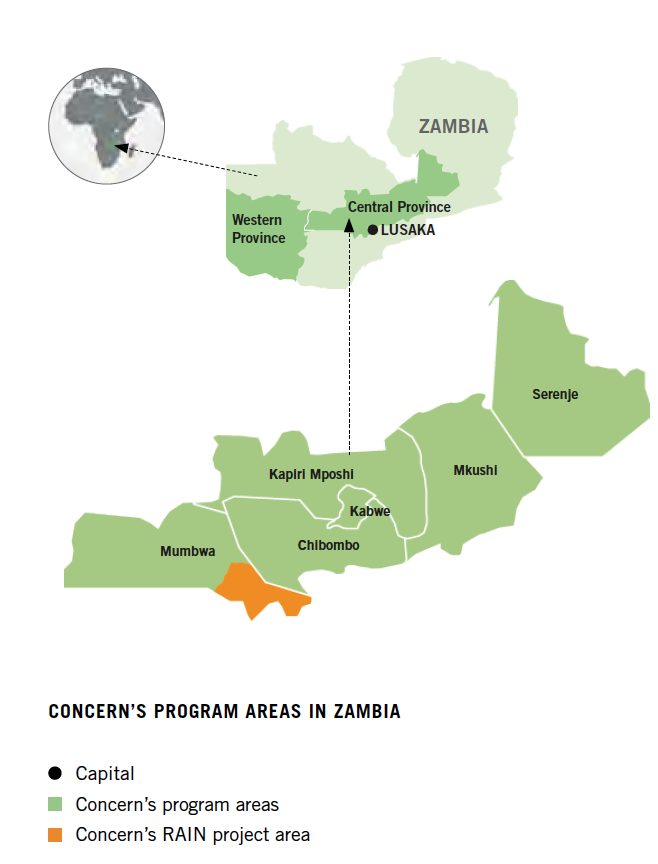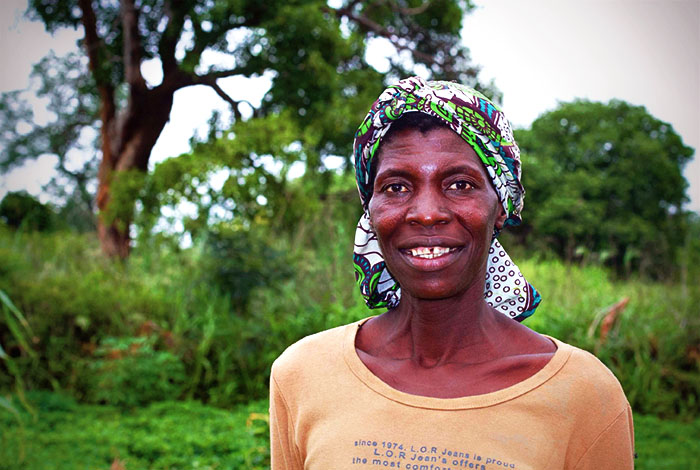Realigning Agriculture to Improve Nutrition (RAIN) Project in Zambia
Increasing dietary diversity is one of the most effective ways to sustainably prevent hidden hunger.
Thompson and Amoroso, 2010
Note: This case study was prepared by Concern Worldwide and reflects this organisation's views and analyses, which have not been peer-reviewed by IFPRI’s Publications Review Committee and cannot be attributed to IFPRI.
Any citation of results or statements from this case study or the 2014 case study by Welthungerhilfe should follow this format: Welthungerhilfe and Concern Worldwide. 2014. “Integrated Approaches toward Improved Nutrition Outcomes,” Ch. 4 in von Grebmer et al. (eds.) 2014 Global Hunger Index: The Challenge of Hidden Hunger. Bonn, Washington, D.C., and Dublin: Welthungerhilfe, International Food Policy Research Institute, and Concern Worldwide.
Box 4.1
Some Basic Facts About Realigning Agriculture to Improve Nutrition
-
Targets more than 4,490 households with pregnant women and/or children below two years of age.
-
Has developed a system where community health workers and smallholder farmers teach women’s groups.
-
Implementing partners: the Ministry of Agriculture and Livestock, the Ministry of Health, the Mumbwa Child Development Agency, and IFPRI.
Note: For more information on this project, visit www.concern.net/news/rain-project-empowering-communities-to-tackle-malnutrition
Concern’s Realigning Agriculture to Improve Nutrition (RAIN) project in Zambia is designed to address the problem of chronic undernutrition by delivering sustainable and scalable cross-sectoral solutions to transform the lives of the poorest and most vulnerable in Zambia.
Of a population of 13 million, more than 60 percent of Zambian people live in rural areas and depend on agriculture for their livelihood (Zambia 2012). In 2014, Zambia ranked 68th in the Global Hunger Index (GHI), with a score indicating levels of hunger that are “alarming.” An estimated 45 percent of Zambian children under the age of five are stunted and suffer chronic malnutrition (UNICEF 2014b). Inadequate nutrient intake is reflected in low dietary diversity scores: Only one-quarter of the children surveyed met the minimum dietary diversity criterion of having eaten four or more food groups the day before, according to a baseline survey conducted in 2011 (Disha et al. 2012).
In 2010, Concern Worldwide Zambia and the International Food Policy Research Institute (IFPRI) began collaborating on the design of a five-year research project which aims to produce and share evidence on how to optimize agriculture for nutrition. The project, which began in mid-2011, has three objectives:
- To reduce the prevalence of chronic malnutrition among young children and improve the nutritional status of pregnant and lactating women in Mumbwa District through targeted interventions during the critical period from conception through the child’s second birthday (the first 1,000 days of life);
- To realign and integrate activities and mechanisms within the Ministry of Agriculture and Livestock and the Ministry of Health, especially at the district level, to more effectively and efficiently achieve sustainable nutritional outcomes; and
- To use and share evidence generated at the district level to influence the local, national, and international policy agenda to prevent child stunting.
One key aspect of the project involves exploring new ways to promote coordination between officials in the agriculture, health, and community development sectors. Malnutrition is a multidimensional problem with many direct and underlying causes. Efforts to address it must be multi-sectoral as increased coordination and alignment between sectors and ministries will be vital for sustained impact on nutrition outcomes. The changes begin at the district level in Mumbwa and cascade down to the community level. In Mumbwa, a District Nutrition Coordination Committee (DNCC) has been established to bring together representatives from the ministries of agriculture and livestock, health, community development, and maternal and child health as well as representatives from civil society.
This model of coordination is considered innovative and effective in supporting collaboration among ministries. It will be replicated across all 14 districts receiving support from the Scaling Up Nutrition (SUN) Fund to implement the First 1,000 Most Critical Days Project.
Approaches within the Realigning Agriculture to Improve Nutrition Project
 Source: Concern based on official maps.
Source: Concern based on official maps.
Box 4.2
SEEDS, LIVESTOCK, AND TRAINING LED TO A MORE VARIED AND NUTRITIOUS DIET
Esnart Shibeleki is a single mother of five. Before joining the Realigning Agriculture to Improve Nutrition project in 2011, she and her family ate two meals a day and they grew two crops: maize and cotton.
The project provided seeds for micronutrient-dense crops, such as amaranth, tomatoes, carrots, soybeans, cow peas, and groundnuts. Now Esnart grows 14 kinds of crops in her garden and also uses a solar dryer to dry her vegetables for consumption later.
“These new crops mean I can better feed my family,” she said. “Now they can eat five times a day—three main meals and two snacks. They drink goat milk and enjoy a more varied and nutritious diet.”
After receiving chickens and a goat, Esnart was also able to add some animal-source protein to her family’s diet, while the manure from the animals improves the fertility of her garden’s soil. In order to ensure decent crop yields, Esnart receives the support of Elly, a smallholder model farmer who monitors her work and checks that the crops are growing well.

Esnart Shibeleki now grows 14 kinds of crops in her garden.
Food Systems
Homestead gardens and small animal husbandry. As in much of Zambia, maize is the main crop grown and consumed in Mumbwa District. Because a key focus of the project is to increase household consumption of foods produced, agricultural activities focus mainly on homestead gardening and small-scale animal husbandry. The project promotes crops based on their nutritional value, including legumes (cowpeas, groundnuts, and iron-biofortified beans); vegetables (amaranth, carrots, green beans, paprika, pumpkins and their leaves, rapeseed, tomatoes); fruits (bananas, granadillas, passion fruit, watermelon); and orange-fleshed sweet potatoes. Because the iron-rich beans mature early, cook quickly, and taste good, they are popular with farmers. In addition, people eat the leaves.
Community health volunteers and smallholder model farmers provide continuing agriculture and nutrition training to groups of 15–20 women, who are pregnant or have children under the age of two. Training covers agricultural practices that boost yields, including how to use organic manure, best practices for integrated pest management, and how to rear small livestock (Box 4.2).
A “pass-on” scheme facilitates livestock distribution. At the start of the project, all smallholder model farmers were given a male and a female goat. One-third of the group members received a female goat and are passing on the goat’s first female offspring to other women in their group. Each woman also received one chicken. The milk, eggs, and occasional meat from the animals are helping to increase families’ micronutrient and protein intake, while the manure the animals produce can be used to improve the fertility of their vegetable gardens’ soil. As access to water for irrigation during the dry season is a big challenge, the project has also rehabilitated boreholes.
Food processing and storage. Household activities focus on improving food preparation and preservation and exploring appropriate time- and labor-saving technologies to maximize women’s time for childcare. In addition, each women’s group received a solar food dryer to preserve fruits and vegetables, increasing access to micronutrient-rich foods, such as cow pea leaves, pumpkin leaves, tomatoes, and okra, throughout the year. While sun drying vegetables is a traditional practice, solar dryers have improved the process by speeding it up, reducing contamination, and minimizing micronutrient loss.
Social and Behavior Change
The RAIN project seeks to optimize food utilization, commonly understood as the way the body makes the most of various nutrients in the food (FAO 2008). Key social and behavior change (SBC) messages aim to change both infant and young child feeding (IYCF) behaviors as well as gender-related behaviors. Messages cover the importance of diversifying diets, nutrition during pregnancy, early and exclusive breastfeeding, the appropriate quantity and quality of complementary foods, and preventive healthcare services, such as immunizations, and ante-natal care. The government curriculum and counselling cards are used to educate women in infant and young child feeding practices, and inform the project’s nutrition activities.
Gender issues are also part of the messaging related to agricultural diversification, nutrition, and health. Women comprise more than 40 percent of the agricultural workforce in the developing world, and more than 50 percent in Africa (FAO 2011). However, many interventions designed to help communities become more food- and nutrition-secure fail to take into account their many roles, demands on their time, and the specific constraints they face. This project seeks to address this failure, not least by securing husbands’ support to work on improving agriculture and nutrition at the household level.
Specific gender-focused social and behavior change materials communicate messages aimed at changing the behavior of beneficiaries and the community at large by changing how they see certain traditions and beliefs about gender roles ascribed by society. These messages promote increased female decisionmaking and a more equitable division of farming and childcare duties. Recognizing the important role that men play, the program highlights the importance of engaging men and boys to support women in their productive and childcare duties. Key messages are conveyed in creative ways, such as plays and cooking demonstrations. Different change agents, including community health workers and agriculture extension agents, reinforce the messages.
Public Health Interventions
The project seeks to work through and build the capacity of existing structures, while increasing overall demand for health services. Government staff and partners train all community health volunteers in infant and young child feeding. In addition, health facility staff train the trainers, leading monthly nutrition refresher classes for volunteers on various topics including maternal health, how to conduct cooking demonstrations, and how to address micronutrient deficiencies. The community health volunteers also help mobilize the community for the twice-yearly Child Health Week and other national days that promote public health.
Supplementation
The project supports micronutrient supplementation by promoting iron/folic acid supplementation among pregnant women, deworming both children and pregnant women, and giving vitamin A supplements to children twice a year. These interventions are highlighted as part of the social and behavior change messaging. The project’s vision is a long-term one, which entails working with people to ensure most of their nutritional needs can be sustainably met through a diverse food system.
Early Indications of Impact
Preliminary results are promising. In less than three years, the production of diverse micronutrient-rich food has increased significantly and child and maternal dietary diversity, a proxy indicator of diet quality, has improved, according to early progress reports. Furthermore, the percentage of women involved in joint decision-making with their husbands or as the sole decision-maker on food production and spending has increased.
Evidence from the project's baseline survey analysis by IFPRI shows that women with high empowerment scores are more likely to have achieved minimum dietary diversity for their children ages 6–23 months and are more likely to have visited a health clinic in the last six months. The percentage of women participating in decisions on what to grow and spending money from the sale of field crops has almost doubled. That said, around half of the women are not participating in such decisions, so these efforts must be expanded.
These and other lessons continue to inform projects in Zambia as well as Concern’s wider agriculture-nutrition programming across Mozambique, Rwanda, Sierra Leone, Tanzania, and Uganda.